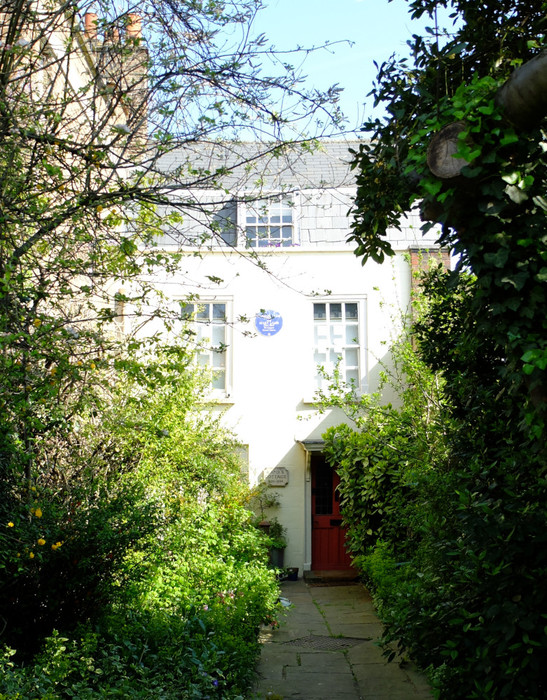This article by Stephen Gilburt was first published by The Enfield Society in newsletter 182, Summer 2011.
“I shall do very well. . .Enfield is beautiful” (Charles Lamb, 1828)
Charles Lamb (1775-1834), who grew up close to Fleet Street, is famous for his “Essays of Elia” and “Tales from Shakespeare”, the latter written for young readers with his sister Mary (1764-1847). In 1827 they moved to Enfield, where Charles hoped that rural fresh air and quiet would be better for Mary. In letters to his many friends he describes places he knew; many of these can be seen on the Enfield Society heritage walks around Enfield Town and Church Street Edmonton.


In 1822, while still working for the East India Company, Charles Lamb wrote to William Wordsworth “I had thought in a green old age … to have retired to Ponders End—emblematic name how beautiful! … toddling about between it and Cheshunt.”

Illustration 3. Before the railway came to Enfield in the 1840s there were three coaches a day between the City and Enfield Town, with a cheaper hourly service between the City and Edmonton. In 1825 and 1827 the Lambs spent their summer holidays at Mrs Leishmann’s boarding-house—the 16th/17th century Clarendon Cottage in Gentleman’s Row (pictured).
In September 1827, after Charles Lamb’s retirement, he moved with his sister and ward Emma Isola, from Islington (see newsletter 179, Autumn 2010, page 5) to the early 19th century Poplars in Chase Side, Enfield. Thomas Westwood recalled “I saw a group of three issuing from the gambogey-looking (yellow) cottage close at hand, a slim middle-aged man in quaint uncontemporary habitments, a rather shapeless bundle of an old lady in a bonnet like a mob cap and a young girl, while before them bounded a riotous dog (Thomas Hood’s Dash) holding a board with ‘This house to be let’ on it in his jaws.”

Illustration 4. In 1829, to relieve the pressure on Mary of running a household, they moved next door to lodge with the Westwoods. The early 19th century Westwood Cottage is on the left.

Illustration 5. Charles Lamb enjoyed his visits to various inns. In 1828 he wrote “We are known at the Horseshoe (the early 19th century Crown and Horseshoes in River View shown above) and the Rising Sun” (an early 18th century inn in Church Street, Enfield, demolished in 1933. See Stephen Gilburt article on Church Street.)

Illustration 6. In her autobiography Mary Cowden Clarke recalled “after a long walk through green Enfield meadows [being] seated with Charles Lamb and his sister on a rustic bench in the shade outside a small roadside inn (the 16th to 19th century Rose and Crown in Clay Hill) quaffing draughts of his favourite porter” (dark beer). She also remembered “the water trough, the dip in the road where there was a ford and a footbridge”.

Illustration 7. After dining too well with his friend Dr Jacob Vale Asbury, the parish surgeon for Enfield, at the 17th century White Lodge in Silver Street, Charles Lamb wrote “I should apologise to you and Mrs Asbury for being absolutely carried home upon a man’s shoulders thro’ Silver Street, up Parson’s Lane by the chapels (which might have taught me better) and then be deposited like a dead log at Gaffer Westwood’s. . .P S what is good for a desperate headache?”

Illustration 8. Chase Side Chapel (rebuilt in 1830, demolished in 1963) and Zion Chapel (built in 1780, replaced by Christ Church in 1874), which Charles Lamb passed on his way home from White Lodge.

Illustration 9. This view of Enfield Town Market Place in 1827 shows the mid-17th century King’s Head (rebuilt in 1899), the 1826 Market Cross (removed to the garden at Myddelton House in 1904), Enfield Grammar School built in the 1590s, the medieval St. Andrew’s Church (with its 1826 south aisle and porch), whose vicar Dr Daniel Cresswell was a friend of Charles Lamb, and the early 17th century Greyhound inn (replaced in 1897 by a bank). Mary Cowden Clarke spent her honeymoon at the Greyhound and wrote “This hostelry possessed a pleasant sitting room overlooking the green and its spreading oak tree”. The building to the right of the Greyhound was replaced in 1830 by the beadle’s office with two lock-up cells.
Charles Lamb missed the sounds, entertainment and shops of London. In 1830 he advised Mary Shelley (the author of Frankenstein) “don’t run to a country village, which has been a market town but is no longer” [where] “clowns stand about what was the market place and spit minutely to relieve ennui” (boredom). Enfield was without a regular market between about 1800 and 1870.

Illustration 10. Mary Lamb, who had killed her mother in 1796 in a fit of insanity, had suffered a series of mental breakdowns while in Enfield. In 1833 the Lambs moved to Edmonton, where Mary became the sole patient at Mr and Mrs Walden’s private asylum at the 17th/18th century timber framed Bay Cottage (now Lamb’s Cottage) in Church Street.

Illustration 11. Charles Lamb died in 1834, Mary in 1847, both being buried in All Saints’ churchyard (see newsletter 178, Summer 2010, pages 4-5).




